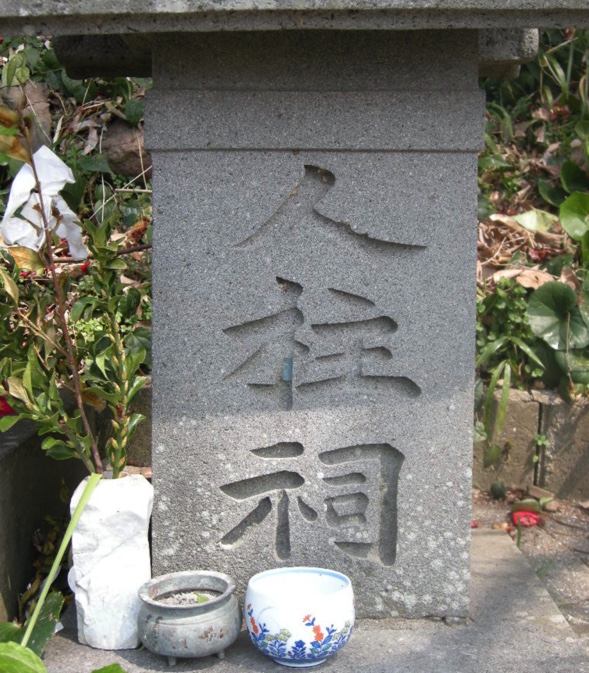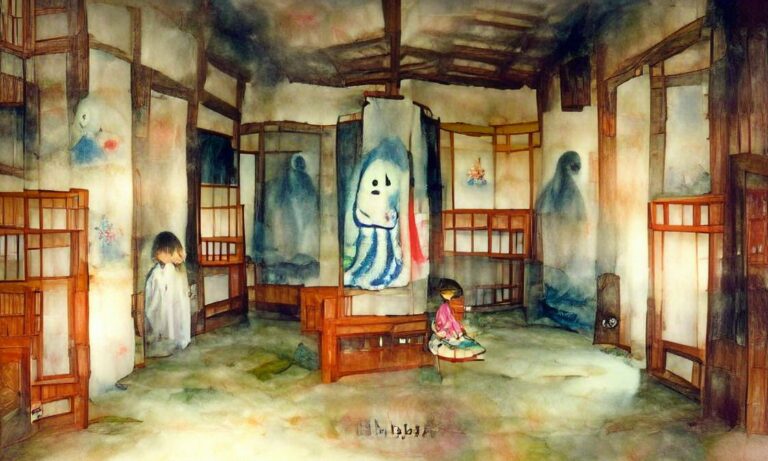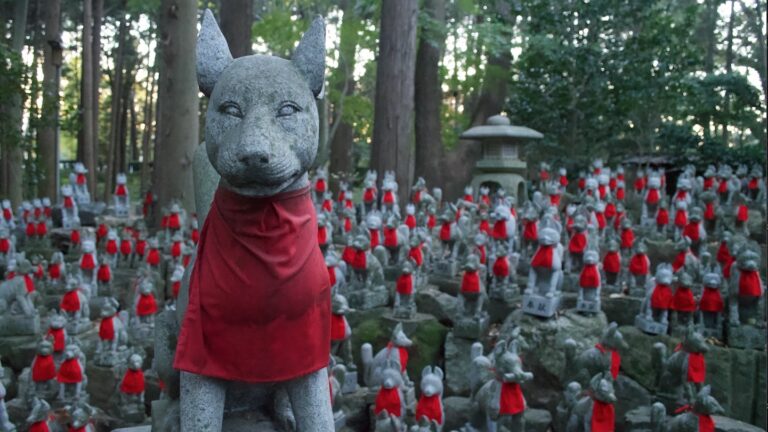Today I’ll talk about a local legend: Nekozuka and Nezumizuka, the Cat’s Grave and the Rat’s Grave. It’s not only a nanafushigi (one of the Seven Strange Happenings), it’s extra special because an old man who has lived his whole life there told me the tale along with some extras his grandfather passed down to him.
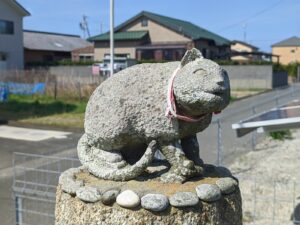
Hey hey, my name is Thersa Matsuura and you’re listening to Uncanny Japan. We’re on episode 99 and I thought wouldn’t it be fun to do another local folktale? This one is also listed as one of the 7-Fushigi of this area, remember those Seven Mysterious Occurrences? (Episode 35 if you’re new ) I’m also fairly confident this is so local that it hasn’t been talked about anywhere else, at least not in English. So shall we?
It’s called “The Cat’s Grave”, Nekozuka/猫塚, but the cat wasn’t the only fatality in this legend. Very much a part of the story is “The Rat’s Grave”, Nezumizuka/ネズミ塚.
Today’s episode is especially special because when I went to take photos of the graves and checkout the area, I got lost. Both the Cat and Rat graves are tucked away on the top of a hill in this idyllic little neighborhood. The roads are narrow, windy, and there are no street signs or house numbers — as anyone who has lived or visited Japan knows well. So I was very lost.
After a kind old lady farmer directed me to the Cat Grave and I finished my investigations there, I was trying to find the Rat one and couldn’t. Several minutes of wandering and I bumped into an old man farmer pushing his wheelbarrow to his corner-plot and asked him if he could help me.
Not only did he show me by drawing a map in the dirt, but he was very excited to tell me parts of the old folk tale that have been passed down through the generations — things his grandfather told him! — but are not found in any online guide or book. So I’ll tell you those sweet little details, too. I’m really excited that I can tell this story as he told it to me and you all can hear it and it won’t be lost to time.
Before I start today’s show, I want to teach you a word, if you don’t already know it. It shows up a lot in Japanese folk tales, manga, and anime. It’s ongaeshi/恩返し. It means something like repayment of a favor or paying someone back after some act of kindness.
You might have heard of it in the fairy tale “Tsuru no Ongaeshi”. Clumsily called on Wikipedia, “Cranes Returning of a Favor”. But I get it. Sometimes these phrases sound so perfect in one language then when you try and translate them to another, they just don’t fit.
Anyway, I guess you could call this story, “Neko no Ongaeshi”. But that’s not what it’s called. It’s called “Nekozuka”, “The Cat’s Grave”.
The Story of Nekozuka and Nezumizuka
It goes something like this:
Mukashi Mukashi, long, long ago, in the coastal town of Omaezaki, there stood a temple called Henjoiin 遍照院. Every day the head abbott would stroll along the oceanside and watch the boats coming in or leaving the harbor. He was a nice guy and liked to make sure everything was going smoothly and everyone was safe.
Saving the Kitten
Well, one day during a bout of rough weather, he noticed a wooden plank out bobbing in the high waves. The monk did a double take. There, drenched and gripping tight to that tossed about board, was a kitten.
Oh, no. Not too far from the near drowning cat was a small fishing boat. The abbott cried out to the fishermen, “Taihen da! Taihen da! There’s a piece of wood with a small kitten hanging on for dear life. Save it!”
The fishermen also being nice dudes, made their way over, scooped up the tiny animal, and delivered it to the head monk. He then took the creature home, and together with the rest of the monks in the temple they nursed it back to health.
Let’s call the cat Mike/三毛 which literally means three hairs, but think of it more as meaning three colors, or a three-colored cat, a calico! Because this little kitten was also a calico and in the story is referred to as Mike often.
The Cat Grew Up
With all the love and attention wee little Mike grew up to be a very clever and cool cat. It got along with everyone, but had a special bond with the head abbott and was said to understand everything he said. Mike’s other special friend was a white cat living nearby. It’s was named Shiro, meaning white. Mike and Shiro liked to hang out together doing their feline duties; napping on warm stones in the sun, chasing after bugs and birds, or otherwise enjoying the salty, fish-scented breeze blowing in off the ocean. It was nice.
The Traveling Monk
For ten years that is. On one particularly fine spring day, a traveling monk showed up at the temple looking for a place to stay for the night. Of course, no problem at all. You can stay for as long as you’d like. The modest temple didn’t usually get visitors so the head abbot and all the monks were happy to have a guest, even though he was a little weird.
On day three of the traveling monk’s stay, Shiro padded over to the the temple and asked Mike would he like to go visit Ise together. But Mike said, “No, I’m not sure why, but I’m concerned about the head abbott. I’m getting a strange vibe.”
The Racket in the Attic
Later that night, there was an incredible racket in ceiling of main hall. It lasted all night long. Even the people living nearby heard it. Come morning everything grew quiet again and they finally went to investigate.
Up in the attic they found the bloodied half dead bodies of Mike and Shiro, but also, next to them, as big as a dog but wearing a traveling monk’s robes was a giant rat. Also bloodied and dead.
Some stories have the rat also barely clinging to life, but the version the old farmer told me had him dead, so I’m going with dead here.
Bake Nezumi
As it turns out, the traveling monk was a bake nezumi, a big old rat that had changed into human form and was planning to kill and eat the head monk of the temple. But Mike figured it out and with the help of his friend Shiro, they battled that bake nezumi and killed it, getting seriously injured in the fight.
The Cat Grave
Despite careful care, the two cats soon succumbed to their injuries and passed away. The entire town was devastated, especially the head monk who had saved the kitten so many years ago. The two cats were given a lovely funeral service and buried next to the temple. A pine tree was planted on the grave in remembrance of the cats’ bravery and Mike’s ongaeshi.
The Mackerel Pine Tree
The pine tree was called Saba-o no Matsu, The Mackerel Pine Tree, because it grew and split like the tail of a mackerel. I don’t know, I would have attributed the splitting of the tree to the spirit of each cat, or likened it to two cat tails. But someone decided to go with mackerel. It doesn’t really matter because at the beginning of the Meiji period, in the late 1800s a strong typhoon blew it down and sadly, it’s gone now.
However, on December 6, 1932, a cat grave marker was erected and it still stands there now, although, it’s missing an ear. To this day people leave little cans of cat food for the spirits of Mike and Shiro. And while not there when I visited, I’ve seen photos of the cat statue with collars or bandanas around its neck. I’ll put photos of the grave up on the website.
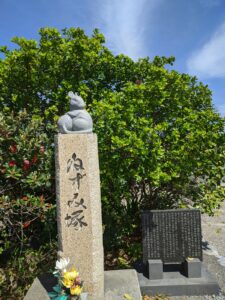
What happened to the Rat?
What happened to the nasty rat? Well, they decided to haul his dead carcass to the shore and throw it into the sea. So several monks grabbed his legs and began to carry him to the ocean.
Here there are different versions of what happened, one says the rat was still alive and spoke to them, while one has them dropping the rat and it appearing in the head abbott’s dreams that night. But the story the farmer told me and I’m going to stick with because first hand information was that as the monks were carrying the dead bake nezumi, it began to get heavier and heavier until they couldn’t lift it anymore. They dropped the creature and then heard a voice saying something like:
The Rat’s Deal
Please don’t throw me in the ocean. I’m sorry. If you give me a proper burial my spirit will keep the seas calm and make sure that all the fishermen who leave port here will come back with lots of fish.
They thought this was a fair deal and made a little grave for the rat right there where they’d dropped it. Today somewhat similar to the cat grave is the rat one, only the rat marker is a whole lot newer. It even has a nearby park named after it and a stunning view of the ocean.
It’s said that indeed the seas calmed and many fish were caught. I’d like to point out the typhoon that knocked over the Saba-o no Matsu pine tree though. Or maybe that was the rat spirit getting a last bit of revenge. Okay, that’s not in the story. Forget that.
Referenced in an Old Japanese Text
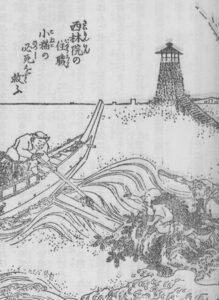
I found online reference to a Japanese book called Kanto Minatan/閑窓瑣談 written by Kyokuntei Tadataka/教訓亭定高 published by Tamenaga Shunsui/為永春水in 1841 that in chapter 7 mentioned a story called “Neko no Chugi”/ 猫の忠義 or Cat’s Loyalty. And it’s very similar to this story.
Some differences were that when they found the animals in the attic, one cat was dead while the other was breathing it’s last breaths and died before it could get any help. The rat was still clinging to life, however, but was quicken beaten with a stick.
The cats were buried on the temple grounds and the rat, after some thought was also buried there because even though he was a monster, we must still have compassion.
Which, I must admit, is an interesting and much more Buddhist way of dealing with the situation.
Extra Information from the Old Farmer
What I learned from the farmer, aside from the story above, is that the original temple is no longer there. It’s just a crop of trees now. It merged into a nearby temple. There is also a shrine in the area that has a really cool legend which he told me about. There’s a full moon, a bridge across the sea, and a dead horse. I’ll do some research on that one and tell it some day here, too.
Another thing he impressed upon me is that the calico cat, Mike, was a male cat. For my cat lovers out there, you know that almost all calicos are female. So the fact that this one was male means that it was quite rare. He said even today everyone in town loves calico cats and if they see a stray they get excited and think, good luck!
And I was just listening to the recording on my way to the Rat Grave, immediately after talking to him, so I wouldn’t forget any details and indeed a little calico trotted across the road while there. So, good luck!
Extra Cat Stuff
Speaking of cats, the last extra content on Pattern was about cat folk belief and old wives tales. Did you know that a little cat spit will cure a millipede bite? Or if your cat gets lost there’s a poem you can write down, attach to the front gate and your beloved pet will come home? It’s true.
Okay, I’ll wrap up here. Thank you so much for listening, everyone stay safe and take care, I’ll talk to you again in two weeks.
Credits
Intro and outro music by Julyan Ray Matsuura
Hip Hop Flute Chill(loopable} by chilledmusic
Link: https://filmmusic.io/song/8531-hip-hop-flute-chill-loopable-
License: https://filmmusic.io/standard-license


